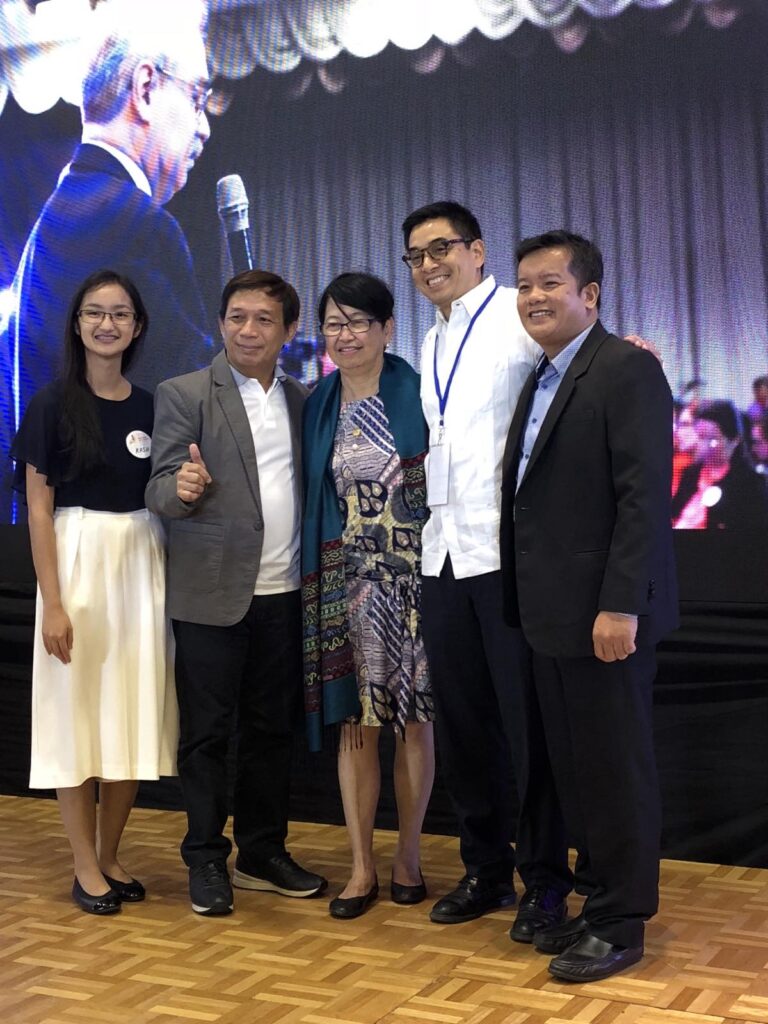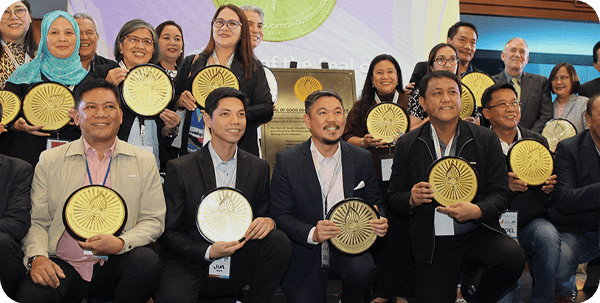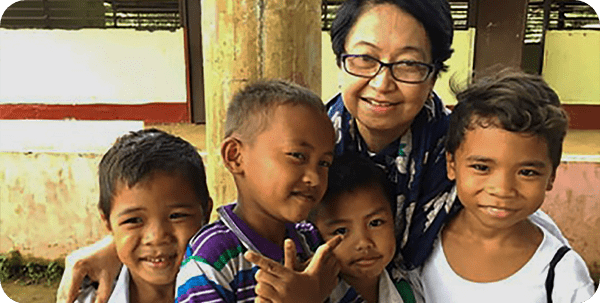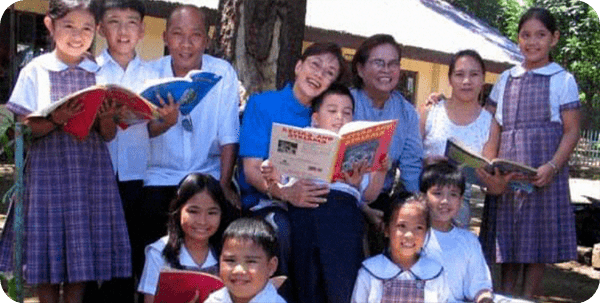A Case Study on Local Leadership and the Education Program
The Mayor’s vision for education was crystal clear. Before entering politics, John Rey Tiangco (former Mayor and now, Congressman) was once a president of a School Governing Council. This experience opened his mind and heart to the needs of children, and led him to prioritize education once he sat in the city hall. His dream was for every child in Navotas to be in school. If they cannot go to formal schooling, there should be catchment programs for them. He once said that with access to quality education, children can become good members of their families and responsible citizens of the community.
When he became Mayor, his vision for education was clear – the city government has to give the best opportunities for all the children. He led consultations with stakeholders and the community to find out what grieves the education system in Navotas. The EdGE Program and Synergeia helped facilitate the education summit that was held in December 2013.
From the summit came about a list of education challenges that needed to be confronted – – poor teaching competencies, lack of support of parents, poverty, large families, dysfunctional families, proliferation of internet shops, child labor, informal settlers, malnutrition and health problems.
He was struck hearing these from children, teachers, parents – –
“Wala akong baon o pamasahe kaya hindi ako pumapasok” (I do not have money for school snacks or transportation so I don’t go to school)
“Hindi sila makapag-focus sa pag-aaral dahil gutom sila” (They cannot focus on their studies because they are hungry)
“Wala nang control ang mga magulang sa anak nila” (Parents cannot control their children)
“Problema na yan ng school at ng teacher” (That is a problem of the school and teacher)
“Iba na talaga ang ugali ng mga bata ngayon” (Children behave differently now)
Mayor Tiangco and the Local School Board prioritized these problems in terms of what could be solved in the short-term. The EdGE Program assisted in terms of capacity building of the LSB and the SGCs so they could be effective partners of the local government in addressing these problems.
And then, there was a pause. For a few years, the EdGE engagement with Navotas City was halted. We did not know what was happening to Navotas. We reached out and in 2017, the partnership was once more alive.
Navotas pursued its education reform, on its own! What did we find out when we reconnected? They formulated the ACHIEVE Program on its own! ACHIEVE is Navotas City’s banner education program that aims to address the challenges and problems of education. ACHIEVE stands for accessible, holistic and inclusive education. Its goal is for all children to be healthy, are in school and studying, and to be the center of the program (“Kasama lahat ng bata sa Navotas; Lahat ay malusog, nasa paaralan, kasama sa hangarin”). All the program components, such as the following, are intended to make education accessible, inclusive, holistic and participative:
- First 1,000 Days program which guides expecting mothers on the important of nutrition and early literacy
- Supplemental Feeding program which addresses the problem of malnutrition early on
- Kindergarten-on-Wheels which is a catchment program for children, usually from the marginalized sector, who cannot enroll in school. The curriculum is accredited and children hold their classes on mobile trucks. Mothers of the children help out by cooking the food which the children partake after their class.
- Pamilyang Navoteno Family Day which is a whole day celebration with families in all schools in Navotas, from day care to high school
- Youth and Kids Ministry which involves interactive values formation workshops for students
- NavotaAs Scholarship Program for students and teachers in academics, athletics and arts
- ALS and Project GEM where “foster parents” provide financial and emotional support to out-of-school children and youth (“oscy”) and students-at-risk (“star”)
- SGC Level Up for the continuous capability building and training of School Governing Councils.
Facets of a community that puts importance on children’s education are seen everywhere. The Local School Board meets regularly every month under the chairmanship of the Mayor. Part of the regular agenda is a report of the Division Superintendent on the education performance of the children. The DepEd and the city budget and planning officials also report on the programs funded by the SEF. The Chairman of the City’s Education Committee said that the LSB makes it a point to invite sectors which are concerned and needed to be consulted on the scheduled agenda. It is akin to expanding the membership of the LSB but in an informal manner. The LGU has an assigned focal person on all education matters and who serves as secretariat of the LSB. She and her team coordinate all the education programs in the city, including making sure that the proposed budget is being prepared on time for presentation to the Board. Mentoring of LSB is a continuing engagement under the EdGE Program.
The Mayor bit the bullet and adjusted the schedule of market values of real properties in Navotas City after 26 years. He did this because the city needed resources for its projects especially for education. He prioritized the implementation of the tax increases to the business sector first and on staggered basis over a 3-year period. He was glad that when he explained his proposal to the community and to business, they softened up when told that the additional revenues to be raised would fund the education of the Navoteno children. It should also be told that the LGU practices the principles of transparency and accountability especially in the use of public funds. The proposed SEF and the quarterly utilization of the SEF are posted in the Transparency Board near the elevators of the city hall building for every taxpayer to see. The LGU has also been resourceful in generating resources by tapping the General Fund, the Fund of the Navotas City Council for the Protection of Children and the Scholarship Fund to supplement the SEF.
This pandemic, Navotas prepared early for the first school year under the distance learning scheme. With the DepEd Division Office’s guidance, the teachers prepared supplementary modules in case the DepEd modules would not arrive in time for school opening. The LGU reached out to Synergeia and EdGE for the conduct of parenting workshop to assist parents on their new roles as teachers of their children at home. Congressman John Rey Tiangco, former Mayor, joined the parents in the entire duration of their workshop. He said he wanted to learn with them, he being a father as well. But he also wanted to give the parents assurance that the city government will always be there to provide assistance to them. Navotas also ran early simulations on module distribution, involving the LGU, schools, parents, SGCs and barangays. The learning resources for every child are placed in a white box they called “Navo-school-in-a-box” that was distributed to all the school children. The box contained not just the modules but also school supplies and additional story books to read.
The SGCs underwent capacity building with EdGE in 2018 and continuous mentoring after. They have become active partners of the schools and the local government in the implementation of programs, especially during this pandemic. The SGC of Dagat-dagatan ES rated their SGC “very good.” They said they help the school and the parents, and they are always communicating with each other on school concerns even if they do not see each other regularly because of the health restrictions. They call their initiative to help in module distribution as their “project modelo” (which stands for “modular delivery through logistic operation”). They also use the materials in the paaralangbahay learning portal of Synergeia as they help parents. They call this their “project panata” (which stands for “patnubay kay nanay at tatay” or guide for mother and father). Another SGC, the Navotas ES, raised funds to donate study tables to the children or “hapag-aralan.” They also donated alcohol and face masks, and use communication apps to reach out to parents and teach them how to use the usb which the LGU distributed.
In the Brigada Eskwela in 2019, communities gathered in schools to help refurbish the school for the opening of the school year. USAID officials, Synergeia, LGU officials, parents and students attended the Brigada in one of the elementary schools in Navotas. A USAID officer led a storytelling session for children while others officers were busy in their respective corners of the school compound painting the school desks.


Team Navotas led by then Mayor John Rey Tiangco together with the DepEd Superintendent Dr. Zurbano, Councilor Lupisan (Education Committee Chairman) and Ms Kash Hilario (education focal for Navotas) posed with Dr Guevara after winning the SGEG in 2018. It was their 1st year to join the search and they won it!
The Schools Division Superintendent drafted a 14-point Education Development Plan for 2017-2022 with the objective to concretize the education vision of the Mayor and to guide the schools in the formulation of their SIPs. The 14 priority objectives aim to attain accessible, quality and liberating basic education in Navotas: 1) achieve zero drop-out rate, 2) improve performance levels in the NAT, 3) achieve 100% promotion rate, 4) increase basic literacy levels from instructional to functional, 5) eradicate malnutrition status of identified wasted and severely wasted learners, 6) ensure commitment to child-friendly school system policy, 7) intensify efforts to provide educational opportunities for OSC and OSYs, 8) ensure that all schools are properly managed using SBM (school based management) principles and tools, 9) promote adoption of single shift scheme, 10) promote training and professional development of all personnel, 11) making PTAs and SGCs more functional, 12) strengthening stakeholders participation and linkage building to support education programs, 13) improve ICT capability and research development, and 14) school performances are measured and recognized. The plan is cascaded to all the schools and School Improvement Plans must be formulated to achieve these 14 priority objectives. Performance of schools is assessed on the basis of how they attained the objectives under the plan.
By the numbers, the results of Navotas’ education performance program shall be known.
And the numbers do not lie.
- Navotas City is a 3-time recipient of the Seal of Good Education Governance. It has submitted its education governance reform program for evaluation in the last 3 years (2018, 2019, 2021), and has been recognized for the same years during the annual National Education Summit (there was no SGEG conferred in 2020).
- The performance of its LSB has improved from 4 (in 2018) to 4.85 (in 2020) using a 5-point assessment scale.
- The SGCs have improved from 3.9 (in 2018) to 4.7 (in 2020) using a 5-point assessment scale.
- Cohort survival rate has increased from 85% (in 2018) to 93.79% (in 2020).
- The decline in the number of frustrated and non-readers has improved from 54.9% to 79% (in 2020).
- The ACHIEVE Program has so far achieved the following:
- Undernutrition is at 1.6% in 2017
- Kindergarten on wheels has graduated 2,449 students as of 2017
- The number of foster parents has increased from 543 in 2016 to 1,075 in 2018
- The ACHIEVE programs are part of the long-term City Development Plan and institutionalized through EOs and Administrative Orders.
- The program design, modules and templates are simple, easy to replicate and have been made available to every community.
There are many lessons learned as Navotas journeyed through the years in its education governance reform mission.
- We need to build and strengthen institutions in order to sustain our reforms. Institutions were strengthened, through continuous capacity building, mentoring and hand-holding, starting from the office of the local chief executive to the LSB, SGCs, teachers and principals, and parents. Institution building is important because the political tenure of the mayor is short while education reform takes time.
- With institution building, ownership followed. Everyone believed in the importance of their education initiatives. They saw their role in the implementation of programs. There was ownership even with the change in the leadership. Navotas is fortunate that it has a “good dynasty” because Mayor John Rey and his elder brother, now Mayor Toby both share the belief that education of children should be a priority in Navotas.
- Broad consultation is necessary in the reform process, and in consultations, it is important to listen. ACHIEVE, a product of broad consultation, is also a product of love of the Mayor for his constituents and of stakeholders in the community who want to see children in school, healthy and with dreams to finish their education.
- Key is the drive and commitment of the Local Chief Executive. He leads the education agenda because he knows, more than anyone else, the problems of the community. He champions education solutions because equips himself, listens to his peers, to his community and to experts, and puts up systems to make sure implementation is on track.
- But passion, love and compassion for the children and for the community are the invisible factors that make real education mayors.
When we saw Mayor John Rey Tiangco seriously painting a school desk during the Brigada Eskwela despite the scorching heat of the summer sun, we undoubtedly and joyfully found one real education mayor.




